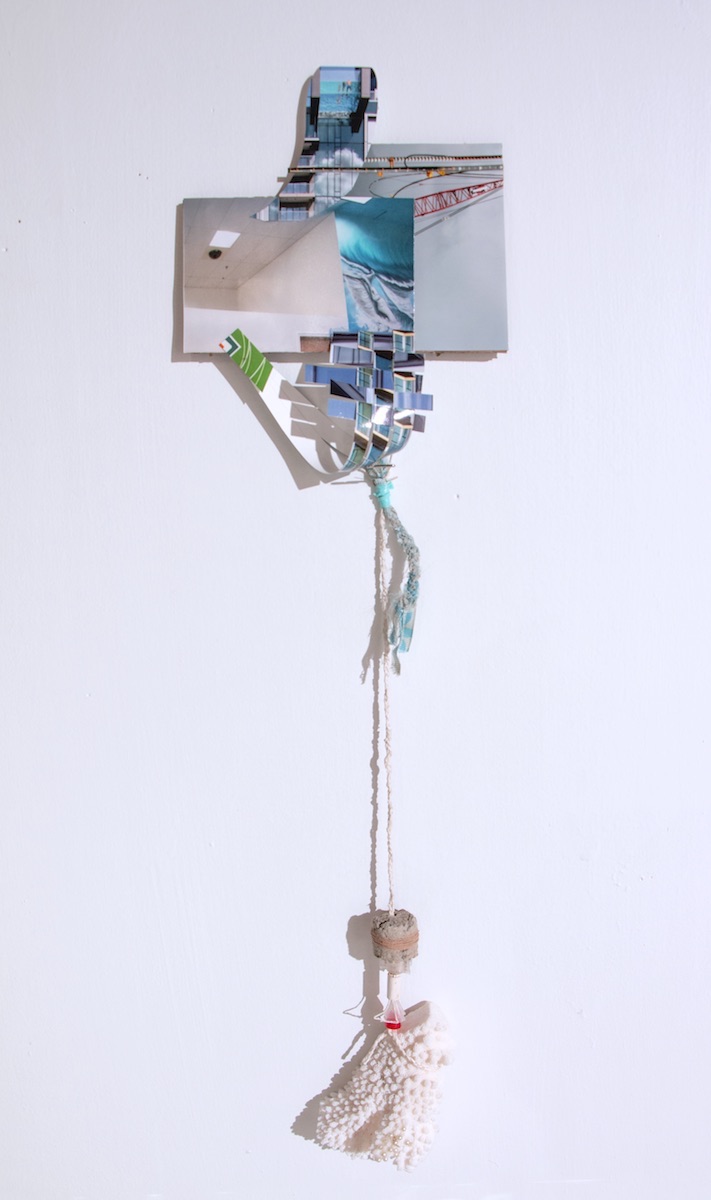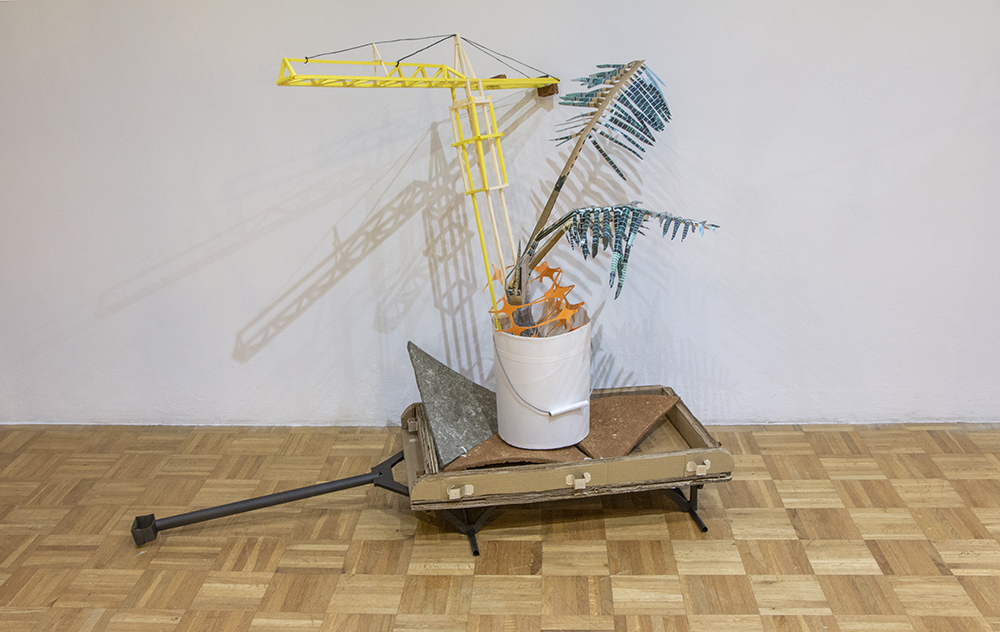Weston Teruya: The Potted Plants of our Undoing
- Anne Lesley Selcer
“It’s like that building trapped the sun!” The child and I were walking east on Mission Street one early evening in spring toward San Francisco’s Millennium Tower. Sunlight refracted through the building’s architecture and shot rays magically upward and outward through the cloud that hovered around the top: a majestic five o’clock crown fit for a Gotham City comic book. The child’s words echoed Weston Teruya’s words on international luxury culture in his studio earlier that week. Handing me a photograph of a swimming pool jutting off the top of a tall glass condominium tower, Teruya said, “It’s as if they’ve taken water from the ocean and put it up there to float in the sky.” The pool’s transparent bottom 12 stories up bragged bodies of pleasure-seekers floating through crystal blue.
 Figure 21
Figure 21
Teruya’s primary-colored assemblages reflect, reverse, and refract this corporate-colonial trick of smooth extractive magic. A potted plant made of green paper grows from a pot constructed from bright white paper. Each spikey-fingered palm frond is constructed from creased photographs of a green glass condominium tower, part of a new 60 acre “master planned” development currently in construction in the artist’s hometown of O’ahu, Hawaii. A construction crane made of yellow paper towers over the plant. Bright orange plastic fencing wraps them both. The paper plant pot rests on several innocuous brown triangles made with dirt from landfills across the street from the condos where bulldozers filled in fish ponds with broken coral, then laid carpets of grass atop. They are paired with grey triangles containing Silicon Valley dirt. The design imitates a new Pacific island tax haven proposed by “tech billionaires and libertarians.”1 The artist has sutured Hawaii and Silicon Valley—a particularly live economic route—into dialog with plastic zip ties. The base of the entire sculpture is a toboggan made of boxes, modeled after the makeshift sleds neighborhood residents used to enjoy the new park’s manmade grass hills.
These assemblages mix Hawaiian vernacular life with post-Postmodern universal condo trash design. A second sculpture balances shiny black rectangles upon the edge of a bright red cooler, one in which families might pack refreshments on a trip to the park or beach. The objects repeat the tiled trimmings, borders and benches of corporate condominium visual language.2 In a third assemblage, an object that looks like a fetish or an artifact leans up against a third paper plant pot. Weston has re-created a bumpy white amputation from an occupied ocean—a Frankenstein beach treasure of coral and plastic layers. These “elemental dislocations,” as the artist calls them, float atop a dematerialized privatized ocean in the Cloud. This series responds to deep changes in the seen and unseen ecologies of physical space.
 Figure 22
Figure 22
The sculptures want to take control over something invincible-feeling and huge. In the cool air of his basement studio, the artist asked,“How do you create something new from things so loaded or poisoned?” According to the research of urban scholar Saskia Sassen, 57 percent of condos worldwide are owned by shell companies as asset-backed securities, abstract financial instruments with materialities attached.3 “Home” is used to anchor oceanic digitized hyper-capital, just as Tahiti may soon literally anchor the tax-exempt fake island. From the cooler, a monster plant grows, its leaves sprouting condo glass. When I point out to the artist that visually, the pieces are still potted plants, sitting ducks, he speaks about their failure at beauty, pleasure: “That’s where I want it to sit.” The corporation building the Ward Village master-planned condo neighborhood underwrites the Honolulu Biennial too. Teruya’s assemblages are the transitional objects of Left melancholy,4 rife with irony, latency, failure, and the last vestiges of the Modern ideas that fueled assemblage.
If talismans, relics, and other ritual objects carry power, will, and intention, what do the artifacts of ostentatious international corporate wealth carry? This is Modernism’s defamilarization and appropriation turned sideways. Weston re-revitalizes the architectural language of revitalized space by embedding it into the complicated layers of the culture it slices into—but the coolers, not the hula skirts. In poetry, reusing language can reassign the rhythms of power. That’s the trick of language’s universality—it’s detachable. These sculptures carry an attitude. If international capital uses art to neutralize, wash away, or butter up its colonization of space, the artist’s irony, ambiguity, and playfulness reattaches condo glass and black-lacquered concrete to the spirit with which they arrived.
Notes
- Gabbatiss, Josh. “World’s first floating city to be built off the coast of French Polynesia by 2020.” The Independent (November 14, 2017) https://bit.ly/2lZVc2p ↩
- “Of the 7,189 units that have been built or approved in Kaka’ako since 2005, less than 8 percent are affordable for low-income households (low income is defined as 80 percent of area media income, or $76,650 for a family of four in 2014)….Here, the sidewalks are not pedestrian promenades connecting hip urbanites to their places of work and play. Instead, they are home to a community of roughly 400 houseless people. Dozens upon dozens of tents line each side of the road.“ Grandinetti, Tina. “Whose Kaka’ako” Flux Hawaii (March 26, 2015). https://fluxhawaii.com/whose-kakaako/ ↩
- Lecture, University of California, Berkeley, March 13, 2018. https://criticaltheory.berkeley.edu/?event=saskia-sassen-talk ↩
- A term coined by Walter Benjamin in the 1930’s. ↩